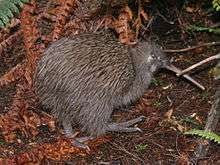North Island takahē
| North Island takahē | |
|---|---|
 | |
| Fossil cranial remains of P. mantelli (7-13) compared to those of a smaller, extant member of Porphyrio | |
| Scientific classification | |
| Kingdom: | Animalia |
| Phylum: | Chordata |
| Class: | Aves |
| Order: | Gruiformes |
| Family: | Rallidae |
| Genus: | Porphyrio |
| Species: | P. mantelli |
| Binomial name | |
| Porphyrio mantelli (Owen, 1848) | |
 | |
| Locations where fossils have been found | |
The North Island takahē or mōho (Porphyrio mantelli) is an extinct rail that was found in the North Island of New Zealand. This flightless species is known from subfossils from a number of archeological sites and from one possible 1894 record (Phillipps, 1959). It appeared to have been even larger than the South Island takahē and, if it did survive until the 1890s, would have been the largest rail in historic times. The decline of the species has generally been attributed to the increasing incursion of forest into the alpine grasslands through the Holocene, although hunting by the Māori also played a major role.
Traditionally the North Island takahē was considered conspecific with the threatened South Island takahē P. hochstetteri. Trewick (1996) presented evidence that the two taxa were independently derived from flying ancestors, so proved to be separate species.
The binomial of this bird commemorates the naturalist and civil servant Walter Mantell.
References
- ↑ BirdLife International (2012). "Porphyrio mantelli". IUCN Red List of Threatened Species. Version 2013.2. International Union for Conservation of Nature. Retrieved 26 November 2013.
- Phillipps, W. J. (1959): The Last (?) Occurrence of Notornis in the North Island. Notornis 8(4): 93-94.
- Trewick, S. A. (1996): Morphology and evolution of two takahe: flightless rails of New Zealand. J. Zool. 238: 221-237.
- Worthy, Trevor H. & Holdaway R. N. (2002): The lost world of the Moa: Prehistoric Life of New Zealand. Indiana University Press, Bloomington. ISBN 0-253-34034-9.
External links
| Wikimedia Commons has media related to |

